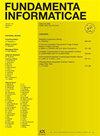k-Abelian等价与合理性
IF 0.4
4区 计算机科学
Q4 COMPUTER SCIENCE, SOFTWARE ENGINEERING
引用次数: 7
摘要
如果对于长度不超过k的单词x, x作为u的一个因子出现的次数与v的出现次数相同,则称两个单词u和v是k-阿贝尔等价类的一些组合性质。我们的出发点是通过重写k-阿贝尔等价的表征,即所谓的k交换。我们证明了等价类的字典最小代表集合是一种规则语言。由此我们推断等价类的数列是$$\mathbb {N}$$ -有理的。我们还证明了定义k-abelian单例类的词集是正则的。本文章由计算机程序翻译,如有差异,请以英文原文为准。
k-Abelian Equivalence and Rationality
Two words u and v are said to be k-abelian equivalent if, for each word x of length at most k, the number of occurrences of x as a factor of u is the same as for v. We study some combinatorial properties of k-abelian equivalence classes. Our starting point is a characterization of k-abelian equivalence by rewriting, so-called k-switching. We show that the set of lexicographically least representatives of equivalence classes is a regular language. From this we infer that the sequence of the numbers of equivalence classes is $$\mathbb {N}$$-rational. We also show that the set of words defining k-abelian singleton classes is regular.
求助全文
通过发布文献求助,成功后即可免费获取论文全文。
去求助
来源期刊

Fundamenta Informaticae
工程技术-计算机:软件工程
CiteScore
2.00
自引率
0.00%
发文量
61
审稿时长
9.8 months
期刊介绍:
Fundamenta Informaticae is an international journal publishing original research results in all areas of theoretical computer science. Papers are encouraged contributing:
solutions by mathematical methods of problems emerging in computer science
solutions of mathematical problems inspired by computer science.
Topics of interest include (but are not restricted to):
theory of computing,
complexity theory,
algorithms and data structures,
computational aspects of combinatorics and graph theory,
programming language theory,
theoretical aspects of programming languages,
computer-aided verification,
computer science logic,
database theory,
logic programming,
automated deduction,
formal languages and automata theory,
concurrency and distributed computing,
cryptography and security,
theoretical issues in artificial intelligence,
machine learning,
pattern recognition,
algorithmic game theory,
bioinformatics and computational biology,
quantum computing,
probabilistic methods,
algebraic and categorical methods.
 求助内容:
求助内容: 应助结果提醒方式:
应助结果提醒方式:


